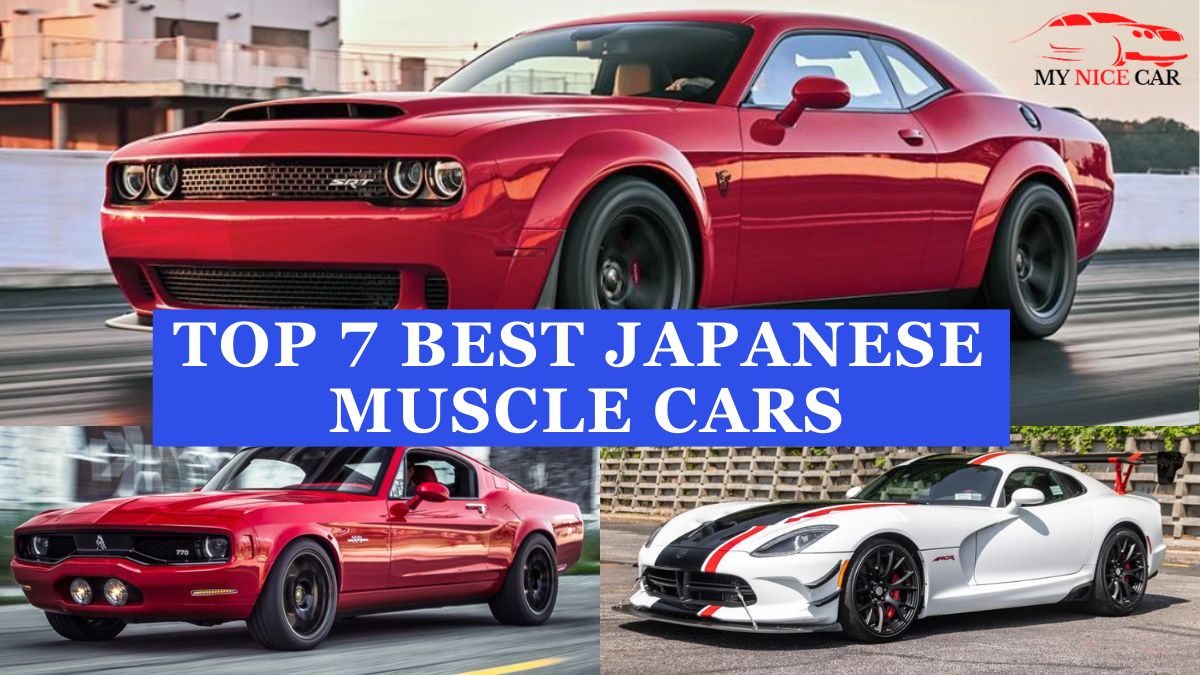In the late 1980s and early 1990s, the muscle car industry in Japan began to flourish. Japanese muscle cars are adored for their high performance, exceptional handling, practicality, and blistering acceleration despite having less power.
For quite a while, muscle vehicles were well known for principally including enormous high-drive motors, forceful body styles, and crazy straight-line speeds. However, with excellent handling and on-track performance comparable to that of many European performance cars, they are currently outperforming Japanese sports cars.
To reduce weight and improve fuel economy, small-capacity Inline engines have been used in Japanese automobiles for a long time. These engines have the advantage of being simpler, more balanced, and can rev quickly without causing damage.
Japanese manufacturers created their versions of American muscle cars with inspired styling and engineering expertise. Therefore, here are seven Japanese muscle cars that must be seen by muscle car enthusiasts!
1) Nissan GT-R Track Edition (2014)
- Horsepower: 600
- Engine: 3.8l V6
Since its 2007 debut, the Nissan GT-R (R35) has captivated gearheads with its 3.8-litre twin-turbocharged V6 engine. The Track Edition is a lighter, limited-edition model with a stiffer suspension that was released for the 2014 model year.
It reaches 60 mph in 2.7 seconds, completes the quarter-mile at 125.1 mph in 10.8 seconds, and reaches its maximum speed of 207 mph.
An oil pan baffle stabilized oil behaviour and pressure when the car is driven hard, and new injectors that provide more torque on the high end of the rev range are added to the engine.
This update has the Nismo rendition’s 600-hp motor and a Nismo-tuned free suspension framework. A new roof made of carbon fibre, wider front fenders, and Nismo brakes made of carbon ceramic were also added.
2) Mitsubishi Lancer Evo X FQ-440 MR (2014)
- Horsepower: 440
- Engine: 2 litres I-4
The Evolution X FQ-440 MR is a four-door sports sedan built on the Mitsubishi GS platform that was only made available in the United Kingdom in 2014 to commemorate the Lancer’s 40th anniversary in the country.
It has a 2-litre turbocharged I-4 engine hidden under the hood, connected to Mitsubishi’s advanced full-time 4WD system (S-AWC). Also, torque goes up slightly, from 400 to 412 lb-ft. The FQ-440’s rear sits 1.1 inches lower than stock thanks to subtle Eibach suspension adjustments that help hunker the nose down 1.3 inches.
The FQ-440 MR is a rally monster with 440 horsepower and 412 lb-ft of torque. It can reach a top speed of 185 mph in 3.5 seconds and can reach 62 mph.
3) Mazda RX-7 Spirit R (2002)
- Horsepower: 276
- Engine: 1.3l
One of Mazda’s finest road cars, the RX-7 Spirit R, was produced in a limited run of 1500 vehicles in three distinct models before the RX-7 was discontinued in 2002. The meanest of the bunch was the Spirit R (Type A) with two seats and a 5-speed manual transmission.
A five-speed manual transmission was paired with a 1.3-litre twin-turbocharged rotary engine that produced 276 horsepower and 231 lb-ft of torque in the most desirable Type-A variant. Twin-red lightweight Recaro sports seats, Gun Metallic wheels, larger drilled brake discs, stainless-steel brake lines, and Bilstein dampers are some features that can be used to identify this top trim level.
With 276 hp and 231 lb-ft of force on draft, it could hit 62 mph in 4.9 seconds and top out at 155 mph.
4) Subaru Impreza 22B STI (1998)
- Horsepower: 276
- Engine: 2.2l
Subaru assembled what is maybe the meanest creation Impreza of all time. Just 424 of these widebody cars, wearing extraordinarily evolved Eibach springs and Bilstein shocks, were assembled. A 2.2-litre turbocharged flat-4 engine that was officially rated at 276 horsepower and 268 lb-ft of torque provided the vehicle with power.
even though its true output is likely somewhere above 300 hp, as part of an agreement between Japan’s automakers at the time regarding horsepower limits.
Weighing in at 2,800 pounds, the 22B STi hits 60 mph in 4.7 seconds and the quarter-mile in 13.5 seconds at 101 mph.
5) Honda Civic Type-R FK8 (2017)
- Horsepower: 306
- Engine: 2l I-4
The main Honda Urban Sort R depended on the 6th era of the Honda Municipal 3-entryway hatchback. While prior ages wore curbed hopes to mirror their sleeper capacities, the Sort R FK8 looks as hot as it drives.
Following in the footsteps of its predecessors, the engine is mated to a close-ratio, six-speed manual transmission that comes standard with a limited-slip differential. The streamlined components increment downforce much further when contrasted with the active model.
In addition, the American-spec I-4 produces 306 horsepower with a 2-litre turbocharger. The Civic Type R FK8 has a claimed top speed of 169 mph and reaches 60 mph in 4.8 seconds. It weighs 3,084 pounds. Additionally, it travels the quarter-mile at a trap speed of 110 mph in 13.3 seconds.
6) Nissan Skyline GT-R V-Spec (R34) (2000)
- Horsepower: 276
- Engine:2.6l I-6
One of the Skyline GT-R’s models, the V-Spec, was introduced in January 1999. It had a stiffer suspension, an active limited-slip rear differential, and the ATTESA E-TS Pro system compared to the standard GT-R. The renowned 2.6-L twin-turbo RB26DETT I-6 engine was mated to a 6-speed manual transmission beneath the hood.
With a slight boost increase, the standard turbochargers were made larger and the ceramic blades were replaced with steel versions.
Independent testing revealed that the actual output was significantly higher than the official rating of 276 horsepower. Regardless of the actual output, this iconic sports car can reach 60 mph in 4.8 seconds and reach its maximum speed of 165 mph.
7) Acura NSX
- Horsepower: 573
- Engine: 3.5l V6
The 3.5-liter twin-turbocharged V6 engine and three electric motors, two of which are part of the SH-AWD drivetrain, make up the hybrid electric powertrain of the second-generation NSX, which is capable of producing 573 horsepower.
The transmission is a 9-speed double grasp programmed. It has a space frame design for its body, which is made of aluminium, ultra-high-strength steel, and other rigid and light materials, some of which have never been used before in the world.
The second-generation NSX can sprint to 60 mph in just 2.9 seconds, while the quarter-mile can be completed in 10.85 seconds.
Conclusion
Although the muscle car formula was discovered in the early 1950s, the term “muscle car” was not coined until the middle of the 1960s. A low-cost shortcut to blistering straight-line performance had been incorporating potent V8 engines into a basic intermediate car.
The engines of the Japanese muscle cars got bigger and more powerful in order to make them go faster, with little or no thought given to handling or ride comfort.
Then again, JDM vehicle producers followed an alternate way to deal with making their vehicles go quickly. They use turbocharging and high-revving engines instead of big, gas-guzzling engines.
They have pioneered manufacturing processes that the rest of the world is scrambling to catch up to by utilising fancy technology. Presently we have Japanese vehicles that are dependable and reasonable.
FAQ
Q.1) Which Japanese muscle cars are considered the most iconic?
The Nissan GT-R, Toyota Supra, and Mazda RX-7 are the best Japanese muscle cars in the market. These cars offer unique designs, impressive performance, and their roles in popular culture.
Q.2) What are some of the latest Japanese muscle cars to hit the market?
It includes the Toyota GR Supra, Nissan 370Z, and Subaru WRX STI. These cars feature advanced technology, sleek design, and impressive performance.




